 |
Fort Fisher
Petersburg, Virginia, USA
|
|
 |
Constructed:1864
Used by: United States
Conflict in which it participated:
US Civil War
|
For the most part, permanent fortifications were not initiated in America during the US Civil War (1861-1865). The latest artillery proved more than a match for the masonry starfort early in that conflict, but the predominant fortification concept of the past 400 years had not been abandoned: Witness the stellar example of the starfortilogical art above! 1864, people! Admittedly, however, the fortifications discussed on this page are best identified as fieldworks.
|
 |
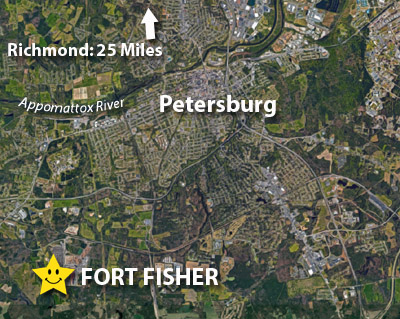 |
|
...for a fieldwork was a fortification that was set up as a temporary stronghold, usually created of earth and wood...which describes the defenses of the Union's West Line, built to the southwest of Petersburg, Virginia during the Civil War.
Because! By 1864, the military forces of the Confederate States of America's days of galloping merrily about, repeatedly defeating much larger Federal forces (usually due to the latter's ineffective leadership) were drawing to a close. A noose fashioned by the not-ineffective Commanding General of the Union Army (and later to become 18th President of the United States), Ulysses S. Grant (1822-1885), was being inexorably tightened around the Confederate capital city of Richmond, Virginia.
|
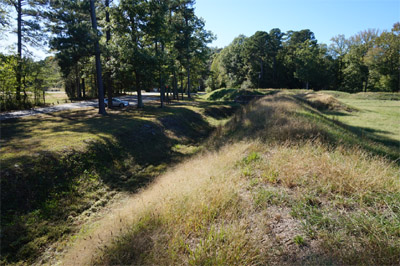 Fort Fisher's southern side, from its southeast bastion. And my car. |
 |
As the Federal army under Grant ground its way towards Richmond, it did not do so undefeated, but unlike previous commanders of that army Grant did not withdraw the instant he lost in battle...which behavior, in the past, had given the Confederates time to regroup and advantageously reposition themselves. Grant kept on coming, wearing down the rebels' limited manpower.
Part of Grant's plan to end the war was to stop the flow of supplies from the Confederacy's southern states to Richmond...which meant he needed to disrupt the Wilmington and Weldon Railroad.
|
|
|
When first established in 1840, the Wilmington and Weldon Railroad was the longest railroad in the world, boasting 161.5 miles of track connecting Weldon, North Carolina to Portsmouth, Virginia and on to Petersburg. Several other railroads connected to the W&W, providing a steady stream of important things (such as food and ammunition) to Richmond. The Weldon wasn't the only railroad connecting the Confederacy to its capital, but from Grant's perspective, it had to go.
|
The Yanks first attacked the Confederate Dimmock Line, which anchored on the Appomattox River to the North of Petersburg and looped around the south of the city, in June of 1864. Initial results were equivocal, but Petersburg remained in Rebel hands.
The blue-coated gentlemen of the North did make some headway, however, and scraped together a series of small fortifications close to the Confederate lines so as to solidify their gains.
|
 |
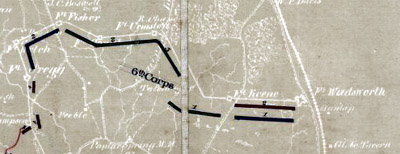
The important segment of a contemporary map by engineer Gilbert Thompson. Fort Fisher is at top left, Fort Wadsworth at the far right, and lots of little fortlets in between. Click it to see the full-sized map which, let's face it, isn't nearly as interesting as this little bit. |
|
The first version of what would become Fort Fisher was a small square work, which mounted seven guns, and was constructed in October of 1864. It couldn't be called Fort Fisher yet, because the Starfort Of Our Current Interest™ was named for First Lieutenant Otis Fisher, who wasn't dead yet! Fisher died from wounds obtained at the Battle of Peebles Farm, which took place on October 2, 1864. After some back-and-forth betwixt the two belligerents, Fort Fisher was rebuilt into its current state (actually much grander than its current state) from January to March of 1865.
Eventually serving as the anchor to the "fish hook" of fortified line to the southwest of Petersburg, Fort Fisher was the largest of those fortifications. All told, the Union lines around Petersburg grew to a length of 32 miles, with 36 individual forts and 50 gun batteries sprinkled thereamongst.
|
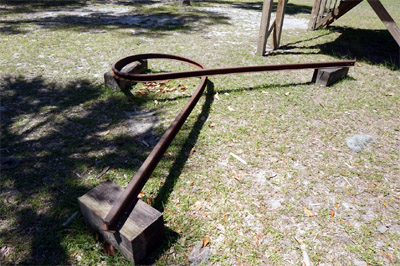
When Federal troops reached Confederate railroads, they frequently left these behind: Sherman's Bowties. Alternately known as Sherman's neckties and, more belaboredly, Old Mrs. Lincoln's Bobby Pins, these were rails that were heated, and then twisted around tree trunks or handy poles so as to render them difficult to use for railroading purposes. This example is on display at Fort McAllister in Richmond Hill, Georgia. |
 |
Fort Fisher is just over 4 acres in size, with positions for 19 guns. It was built for a garrison of 300, and had three powder magazines within: Looking at the image at the top of this page, the longest of the three is the most obvious, slashing diagonally across the middle of the fort; The other two, smaller magazines are directly behind the bastions on the left.
Fort Fisher was never attacked by the wicked Southrons, who had numerous other pressing concerns to deal with at the time. A single gun was fired from Fort Fisher's parapets in the morning of April 2, 1865, which "portended the doom of Petersburg." This was the signal for the Union's final assault on the city to get underway. The Dimmock line was in shambles, and the Weldon Railroad had been cut: The Confederates had no recourse but to abandon the city. |
|
|
The Siege of Petersburg, which had lasted over nine months, was over on April 3rd. The extensive line of earthwork fortifications were immediately abandoned by everyone involved, because who wants to exist in a muddy ditch for one moment longer than is absolutely necessary?
|
Confederate commander Robert E. Lee (1807-1870) led what was left of the rapidly diminishing Army of Northern Virginia 96 miles to Appomattox Courthouse over the next six days, where he finally surrendered to US Grant. The war was over! Long live the war! Today, Fort Fisher is the coolest stop on the Petersburg National Battlefield's Western Front Driving Tour. While certainly diminished from its original form, it's in extremely good condition for a 150-year-old fieldwork! The Western Front also features Union works Fort Urmston, Fort Conahey and the stellar Fort Wadsworth, the latter of which will likely merit its own page at this site in the near future.
|
 |
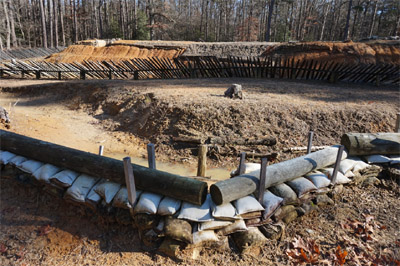 A reconstructed section of the infantry earthworks that surrounded Petersburg during the Civil War, at the excellent Petersburg Battlefield Eastern Front Driving Tour. Looks like a pleasant locale at which to conduct one's business for nine months, right? A reconstructed section of the infantry earthworks that surrounded Petersburg during the Civil War, at the excellent Petersburg Battlefield Eastern Front Driving Tour. Looks like a pleasant locale at which to conduct one's business for nine months, right? |
|
Just a smidge to the west of Fort Fisher is the Confederate Fort Welch, a cute lil' thing that was the destination for the Union troops unleashed by the shot fired from Fort Fisher on April 2, 1865. I have lived in nearby Richmond, Virginia for the past 30+ years, and somehow managed to know nothing about these forts in my backyard until 2017! My Super Starfort Sense must be damaged! |
|
The reason there aren't all that many pictures of Fort Fisher on this page is that there isn't a whole lot to see of Fort Fisher! Rest assured, I took plenty of pictures there (film is cheap these days!), but two-dimensional images of relatively indistinct earthen mounds don't always translate to an arresting sight on a computer monitor. Nonetheless, here are two more! Above left we see the interior of Fort Fisher from its northwest bastion area; and above right we have the inside of the fort's big powder magazine. |
|
|
|
|
|
 |




